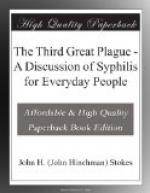+The Mistaken Conception of “Single Dose Cure."+—In the light of his experience with salvarsan in animals, Ehrlich hoped to accomplish the cure of syphilis in man by a single dose of the new drug, as he had been able to cure it in rabbits. All the earlier use of salvarsan in the treatment of syphilis was carried out with this idea in view, and the remarkable way in which the symptoms vanished before the large doses used encouraged the belief that Ehrlich’s ideal for it had been fulfilled. But it was not long before it was found that syphilis had a stronger hold on the human body than on animals, and that patients relapsed after a single dose, either as shown by the blood test or by the reappearance, after varying intervals, of the eruption or other symptoms of the disease. Unfortunately, the news of the discovery of salvarsan, and with it Ehrlich’s original idea that it would cure syphilis by a single dose, had gotten into the newspapers. Numbers of syphilitics treated with it have been deceived by this notion into believing themselves cured. In those whose symptoms came back in severe form, the trouble was, of course, found out. But there are at the present time, undoubtedly, many persons who received a single dose of salvarsan for a syphilis contracted at this time, and who today, having never seen any further outward signs of the disease, believe themselves cured, when in reality they are not. In the next twenty years the introduction of salvarsan will probably result in a wave of serious late syphilis, the result of cases insufficiently treated in the early days of its use. It was not long before it was found that not one but several doses of salvarsan were necessary in the treatment of syphilis, and soon many physicians of wide experience began to call in mercury again for help when salvarsan proved insufficient for cure. At the present time the use of both mercury and salvarsan in the treatment of the disease is the most widely accepted practice, and seems to offer the greatest assurance of cure.




